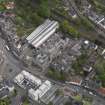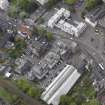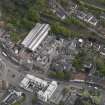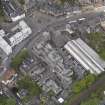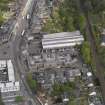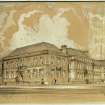Linlithgow, High Street, County Buildings
County Building (20th Century), County Building (19th Century)
Site Name Linlithgow, High Street, County Buildings
Classification County Building (20th Century), County Building (19th Century)
Alternative Name(s) 122 Main Street; West Lothian County Buildings
Canmore ID 188253
Site Number NT07NW 140
NGR NT 00203 77095
Datum OSGB36 - NGR
Permalink http://canmore.org.uk/site/188253
- Council West Lothian
- Parish Linlithgow
- Former Region Lothian
- Former District West Lothian
- Former County West Lothian
County Buildings, 1935, J Walker Todd
Unspectacularly neoclassical, like an overscaled town house underscaled for location, pavilion roof surprisingly undemonstrative in this street of romantic skylines. Lacks fizz. Smart interior with good Raeburns, etc. Exceptional masonry and interior craftwork joinery for its date.
Taken from "West Lothian: An Illustrated Architectural Guide", by Stuart Eydmann, Richard Jaques and Charles McKean, 2008. Published by the Rutland Press http://www.rias.org.uk
NMRS REFERENCE
Architect: David John Chisholm (of Peddie, McKay & Jamieson).
Publication Account (1996)
A site for new County Rooms designed by William Burn, 'immediately behind the Town House, and connected with the Sheriff Court Room', was granted to the county by the town council in 1819 at a low feu-duty. The W front, which faces Kirkgate, is of six bays, the end ones being slightly advanced. These end-bays contain segmental archways, the S one enclosing the entrance-doorway and the other opening to a pend. The ground-floor windows are round-arched within recesses of similar form whereas the upper storey has large rectangular windows. The entrance-hall, whose ceiling was supported on four timber columns, and the elaborate staircase to the S, were removed in 1962-3, when the first-floor committee-room and county hall were combined.
Information from ‘Tolbooths and Town-Houses: Civic Architecture in Scotland to 1833’ (1996).






































